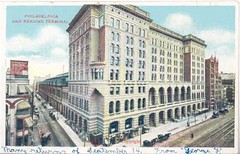Revitalization lessons: comparing Philadelphia and Washington, DC
Posted on Wed, Oct. 29, 2003 -- Philadelphia Daily News
An outsider's vision for saving Philly
By RICHARD LAYMAN
RECENTLY, I was in Philadelphia attending a conference on commercial corridor revitalization.
Comparing your city to my own Washington, D.C., made me think. While I can't claim to have all the solutions, I realized that three things are needed to enhance the vitality of our traditional cities, regardless of public-safety and substandard services, including public schools.
No. 1 is the job core at the heart of the city.
We know that a strong core is required to drive demand to reoccupy vacant housing, particularly by those who don't want to spend a lot of time commuting. Focus on job development, retaining businesses and attracting new ones.
No. 2 is solid public transportation.
A tour of Girard Avenue convinced me that major investment in non-automobile transportation is essential to the revitalization of our traditional cities. Bringing back the trolleys to surface streets like Girard makes vacant houses worth occupying and rehabilitating.
No. 3 - recognize the value of your historic housing stock.
Buildings that Philadelphians think are worthless would go for a million dollars in Washington.
It's pretty much proven that the only urban revitalization strategies that work long term are based on historic preservation. Ignore that at your peril.
Dump the demolition piece of the Neighborhood Transformation Initiative - begin by transforming the neighborhoods within 2 miles of the central city - and sell the houses for $1 with covenants that forbid teardowns. Instead of spending millions on demolition, put the money into a revolving fund to provide loans for restoration and rehabilitation.
Forget the people who want to live in the suburbs. Attract urban pioneers-homesteaders interested in buying historic houses with seemingly little value but great attributes and close-in location. Provide incentives for public transportation, not autos.
Think D.C.'s Capitol Hill in 1979, when rowhouses cost $80,000. They're now worth over $500,000. People walk to work or use public transit, and many use cars only on weekends.
Architecture and history define Philadelphia. Taking your city away from the pedestrian and remaking it for the automobile destroys your marketing and competitive advantage.

Reading Terminal building, Market Street, Philadelphia, postcard
Sure, you need to improve municipal services and public safety. But in Washington, our crime rate is going up, our public schools aren't great, and the improvement of most city services seems to have stalled. Even so, demand for housing in the center city is strong - thousands of new units are being constructed, houses vacant for years are being renovated, and our neighborhood commercial districts are beginning to turn around.
In D.C., we have a retail broker named Len Harris. He works diligently to attract retail to the city. He said something to me that really hit home - that we aren't working on these issues for us as much as we are rebuilding the city for the next generation. Maybe we can't convert people who live in their cars or who value a historic row house only for a post-demolition empty lot. Focus on the people who cherish city living. There are enough of us to make the difference.
After the conference, we walked South Street, stocked up at the Italian Market, where food costs as little as a third of that at D.C.'s wonderful Eastern Market. We hit the art walk in Centro de Oro, saw amazing street theater and the beautiful "La Casita" art-photographic installation at Congreso de Latinos Unidos.
Finally, we drove along Germantown Avenue and ended up in Mount Airy, at a wonderful restaurant and club called North by Northwest. After dinner we stuck around. At 10 p.m., they pulled out the tables and it became a dance floor - perfect for the explosive Brazilian dance and music performance that featured as many as 13 performers on the stage at any one time.
I left Philadelphia intrigued and heartened and wanting to come back - soon. What a city you have.
Labels: urban revitalization



0 Comments:
Post a Comment
<< Home